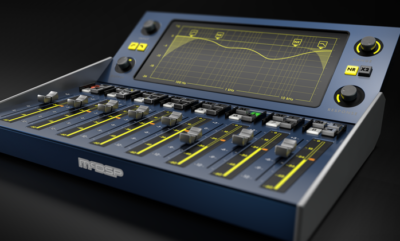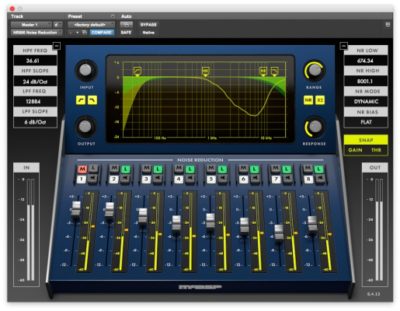New Software Review: NR800 Noise Reduction Processor by McDSP

The McDSP NR800 is meant to be a comprehensive noise reduction tool, offering solutions for music production, live sound, and audio post applications.
Noise reduction is a subtractive art. In the right hands, it can be used like a scalpel that leaves no scars, but in the wrong hands, and used to excess, it can be more like a machete.
When cleaning up a signal, I start with the thing that is least destructive to the source material and go from there.
To start, simple editing leaves no artifacts! Just cut out the noisy parts. If the noise is happening simultaneously with the sound that you need to preserve (for example a low hum or high buzzing), a little EQ can go a long way. Gain riding is the original noise reduction; turn it down a bit between phrases, but not too much. And when all else fails, I turn to digital noise reduction—the most magical method… but going this route can generate peculiar sounding artifacts.
The NR800 is a new audio noise reduction plugin created by the fine folks at McDSP (McDowell Signal Processing). A dynamic noise suppressor with 8 fixed bands of noise reduction, the NR800 offers a wealth of controls to clean up your signal, including well-implemented high and low pass filters before high quality noise reduction.![]()
The plugin runs both in real-time and Audio Suite, has no internal latency, and can be fully automated. Today, we’ll take a close look at the NR800 and see if it’s worthy of a spot in your production toolkit.
Features and Use
I ran the NR800 on a Macbook Pro using Pro Tools 12. The installation was straightforward and authorized via iLok. I found no manual, but a few short videos on the McDSP website offer a clear and simple explanation of the software.
The upper center section of the NR800 hosts a generous display for your current settings and the audio being processed. On the left side are controls for high and low pass filters, with selectable slopes of 6, 12, 24, and 36 dB per octave. A host of global parameters on the right offers 6 different noise reduction modes—from smooth to fast—and a bias mode for further tailoring the reduction to the specific noise being targeted. Two Snap buttons on the right provide quick initial settings for any problematic sound.
While playing the clip you want to affect, first click Threshold; this will set the level below which the noise reduction begins working. Then click Gain, which suggests a setting for each fader. From there you can fine tune the results to taste.
As I work mostly with dialogue, much of my experience using the NR800 was specific to that—but it’s important to note that this plugin can be used on any kind of noisy track. The 6 algorithms provide solutions for lots of problems seen in everything from individual instruments to fully mixed tracks.
The trick with noise reduction is to get rid of the unwanted noise while preserving the integrity of the sound—so what works on one kind of noise or source material may not work on another. Too much noise reduction will produce artifacts, but it’s all contextual; you may be able to apply loads of NR to a single instrument (like a snare drum) that sits among other sounds without issue. However, dialogue (which I mix a lot of) is usually mixed way out front with not much to hide behind, so even small artifacts become apparent, especially in long stretches of speaking.
I started using the NR800 on interviews from a documentary that had varying degrees of noisiness. I applied the high pass filter at 90 Hz to clear out rumble that isn’t in the way of the voice, which helped a bit. I then did a snap analysis for threshold during speech, which set thresholds to varying starting points. From there, I went through each of the 8 faders to see what they do. Sometimes room ambience is broadband, so any noise I turn down may share frequencies with dialogue and thus possibly make things worse. By flexing each fader, I could easily hear how the voice was being affected. If the threshold is above the fader, frequencies in that band get reduced; if the threshold is below the fader, the band is turned up. It’s superficially like a graphic EQ, but the processing is dynamic.
I ended up applying most of the reduction to the low end, with a bit of boosting in the mids. This removed as much as 12 dB of the bass in the room tone, producing a result that was more open and natural sounding. But be careful; if you move the faders just a little too far, it starts to sound like somebody threw a blanket over the speaker.
I fixed or mitigated a variety of problems with male and female subjects using the NR800. Each of the 6 NR modes offers its own algorithm to address different issues. Together the snap, threshold and gain allowed me to audition a wide range of options very quickly, improving the efficiency of my workflow.
The NR800 responded well to heavy background noises; the algorithms McDSP has implemented do an excellent job of pulling out noise while leaving the important aspects of your sound intact. The ability to go from gentle to steep slopes on the filter section is wonderful for controlling your low end; the 6 dB slope provides a gentle rolloff for subtly intrusive problems while the 36 dB slope is far more aggressive.
McDSP has built many well thought-out efficiencies into the NR800, making it stand out among its competition. For example, any fader or threshold can be linked with others for a VCA-style group, with master and link controls per fader. The filter section and noise reduction can be bypassed individually, and individual faders can be muted.
Depending on the project, I sometimes have to perform individual noise reduction on many clips to make everything sound smooth and consistent, and the NR800 enabled me to address problems quickly and without a lot of fuss. I used the 2x button frequently to check the overall curve I was building; it helped me fine tune the audio to the most natural-sounding setting. In addition, it’s crucial that the NR800 can operate in real-time and be automated—this is something you can’t do with a sample and render approach.
To Be Critical
It’s not often you come across a plugin that you feel wouldn’t benefit from at least a few small changes or improvements. Oftentimes performance and design might be on point, but perhaps the user experience is lacking. Sometimes there’s one small design choice that seems counter-intuitive, or can tack on a few extra minutes to your workflow. With the NR800, I honestly can’t find anything to critique. This plugin is absolutely fantastic at non-destructively eradicating unwanted noise from a variety of source material, and it allows you to do so with ease.
Summing it Up
The NR800 by McDSP is among the best of its breed; you’ll be amazed at just how well it can clean up a messy signal—whether in dialogue or music applications. Priced at $149 for Native and $179 for HD, the NR800 compares favorably on a sonic level with plugins and hardware units that cost much more, and is sure to be a valuable addition to the arsenal of anyone working in music production, live sound, or audio post.
Please note: When you buy products through links on this page, we may earn an affiliate commission.







